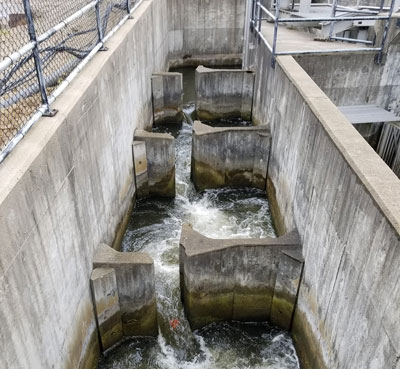 The South Bend Fish Ladder is managed by Indiana DNR's Division of Fish & Wildlife. It is part of the St. Joseph River Trout and Salmon Project. The project was created in the late 1970s by Indiana and Michigan, with support from various partners. Completed in 1992, the project included the construction of five fish passage facilities and helped establish a world class trout and salmon fishery on the Indiana stretch of the St. Joseph River.
The South Bend Fish Ladder is managed by Indiana DNR's Division of Fish & Wildlife. It is part of the St. Joseph River Trout and Salmon Project. The project was created in the late 1970s by Indiana and Michigan, with support from various partners. Completed in 1992, the project included the construction of five fish passage facilities and helped establish a world class trout and salmon fishery on the Indiana stretch of the St. Joseph River.
Fish ladders provide a set of vertically slotted pools that look like a staircase and allow fish to swim around dams on the river that would otherwise stop their progress upstream. There are three fish ladders in Michigan’s section of the St. Joseph River (Berrien Springs, Niles, and Buchanan) and two in Indiana’s section (Mishawaka, at Central Park, and in South Bend at Seitz Park). These fish ladders enable fish to move freely throughout the lower 63 miles of river, from Lake Michigan upstream to the base of the Twin Branch Dam in Mishawaka.
DNR biologists monitor the fish passage using a motion-activated video camera in a viewing window within the ladder. This allows them to count the fish, study the timing and strength of fish runs, provide fishing reports to anglers, and evaluate the success of stocking programs to improve fishing.
The public can visit Indiana’s fish ladders and view fish moving through the chambers from above. To allow successful passage, no fishing is allowed within 100 feet of the fish ladder entrance and exit.
- How to use this interactive dashboard
- Desktop and mobile versions may appear slightly different.
- The date of the last update will appear at the top of the dashboard.
- Selecting different filters will change counts based on selection. If counts are left blank, then no data is available for the current selection. Filters are based on the current day (not the last updated day).
- Top filter will only change the counts and will not impact the charts at the bottom.
- Click the table icon to view daily current or historical counts.
- Charts can be filtered by species and year.
- The display of this page has been tested with various devices, screen sizes, and web browsers. Even with this testing, there may be display issues with some specific devices and browsers.
- How to interpret results
- NR staff will update the counts as often as they can. During busy time periods, updates may be delayed.
- Counts can help monitor fish movement and provide peak time periods for anglers to target certain species.
- Historical counts are available dating back to 2011.
